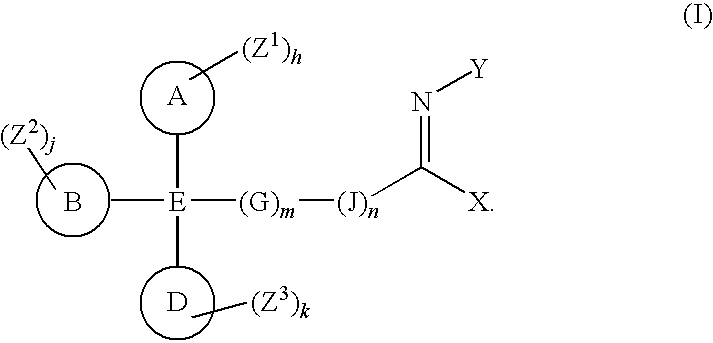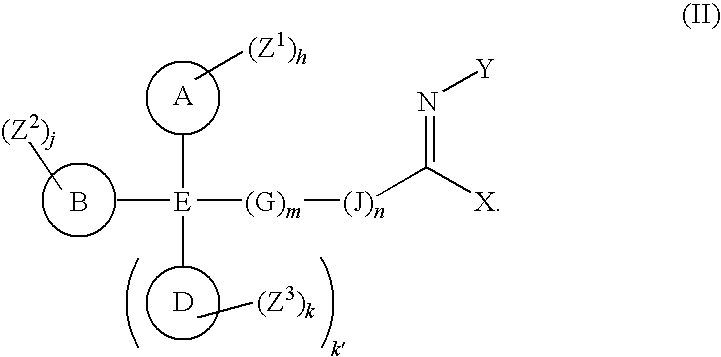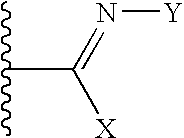Imines as ion channel modulators
a technology of imines and ion channels, applied in the preparation of isocyanic acid derivatives, drug compositions, extracellular fluid disorders, etc., can solve the problems of reducing blood pressure and breathing difficulties, red eye and blurring of vision, and hampered cell proliferation of gardos channel inhibitors that have been explored to date, so as to reduce sickle cell dehydration, and treat and/or prevent sickle cell disease.
- Summary
- Abstract
- Description
- Claims
- Application Information
AI Technical Summary
Benefits of technology
Problems solved by technology
Method used
Image
Examples
example 1
Preparation of 3
[0299]1.1 General Method
[0300]To a solution of 6.6 mmol of 1 (1a or 1b) in 50 mL of anhydrous THF was added 33 mmol of 2 at room temperature under N2. The reaction mixture was stirred for 0.5 h before quenched with saturated NH4Cl. After the mixture was made basic with NH4OH, the mixture was extracted with EtOAc. The organic phase was washed with saturated NaCl, dried over MgSO4, and concentrated in vacuo. The residue was purified by column chromatography on silica gel to give 4.2 mmol of 3.
[0301]1.2 Results
[0302]Analytical data for exemplary compounds of the structure 3 are provided below.
[0303]1.2.a (2-Chloro-6-methyl-pyridin-3-yl)-bis-(3-fluoro-phenyl)-methanol
[0304]1H NMR (300 MHz, CDCl3) δ 7.35-7.26 (m, 2H), 7.05-6.91 (m, 8H), 2.54 (s, 3H); MS m / z: 346 (M+1).
[0305]1.2.b Bis-(3-fluoro-phenyl)-(6-methyl-pyridin-3-yl)-methanol
[0306]1H NMR (300 MHz, CDCl3) δ 8.27 (d, J=2.3 Hz, 1H), 7.51 (dd, J=8.2 Hz, J2=2.4 Hz, 1H), 7.31-7.24 (m, 2H), 7.12 (d, J=8.0 Hz, 1H), 6.99-6...
example 2
Preparation of 4
[0307]2.1 General Method
[0308]To 5.0 mmol of 3 in 50 mL of dichloromethane was added a 20% solution of acetyl chloride in dichloromethane (10 mL) at rt. The resulting solution was stirred for 12 h before the solvent was removed in vacuo to afford crude chloride intermediate which was used without purification in the next step.
[0309]To the residue was added 5.5 mmol of copper cyanide and the resulting mixture was heated at 130° C. for 3 h. When the reaction mixture was cooled to 110° C., 30 mL of toluene was added and the mixture was stirred for 10 min. After mixture was filtered and the solvent was removed in vacuo, the residue was purified by column chromatography on silica gel to give 3.2 mmol of 4.
[0310]2.2 Results
[0311]Analytical data for exemplary compounds of the structure 4 are provided below.
[0312]2.2.a (4-Fluoro-phenyl)-diphenyl-acetonitrile
[0313]1H NMR (300 MHz, CDCl3) δ 7.48-7.28 (m, 6H), 7.27-7.17 (m, 6H), 7.04 (t, J=8.2 Hz, 2H), MS m / z: 288 (M+1).
[0314]2...
example 3
Preparation of 6
[0318]3.1 General Method
[0319]A mixture of 14.5 mmol of 5, 2.9 mmol of acetonitrile, and 26.1 mmol of NaH (60% in mineral oil) in 30 mL of anhydrous toluene and 5 mL of 1,4-dioxane was stirred at 110° C. for one day. After being cooled to rt, the reaction mixture was quenched with saturated NH4Cl, made basic with NH4OH, and extracted with EtOAc. The organic phase was washed with saturated NaCl, dried over MgSO4, and concentrated in vacuo. The residue was purified by column chromatography on silica gel to give 10.2 mmol of 6.
[0320]3.2 Results
[0321]Analytical data for an exemplary compound of the structure 6 are provided below.
[0322]3.2.a Bis-(6-methyl-pyridin-2-yl)-acetonitrile
[0323]1H NMR (300 MHz, CDCl3) δ 7.96-7.90 (m, 2H), 7.48 (dd, J=5.4 Hz, J2=7.5 Hz, 2H), 6.93 (dd, J=8.3 Hz, J2=2.8 Hz, 2H), 5.30 (s, 1H); MS m / z: 224 (M+1).
PUM
| Property | Measurement | Unit |
|---|---|---|
| delay time | aaaaa | aaaaa |
| delay time | aaaaa | aaaaa |
| delay time | aaaaa | aaaaa |
Abstract
Description
Claims
Application Information
 Login to View More
Login to View More - R&D
- Intellectual Property
- Life Sciences
- Materials
- Tech Scout
- Unparalleled Data Quality
- Higher Quality Content
- 60% Fewer Hallucinations
Browse by: Latest US Patents, China's latest patents, Technical Efficacy Thesaurus, Application Domain, Technology Topic, Popular Technical Reports.
© 2025 PatSnap. All rights reserved.Legal|Privacy policy|Modern Slavery Act Transparency Statement|Sitemap|About US| Contact US: help@patsnap.com



